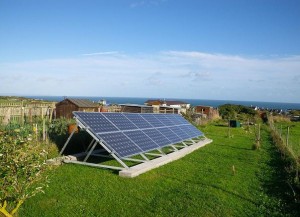
How Your Home Can Produce MORE With Less
When I walk through my home and around my yard, I'm constantly looking for ways to do more with the space I have available.
More? No, I'm not talking about finding ways to store more stuff by stacking and packing it in every nook and cranny.
Instead, I'm talking about finding ways to produce more in less space.
One of the secrets I've found to producing more, is to stack functionality so that the same space can do many things simultaneously.
 Here's an example. Here's ground mounted solar system that a family in Devon, UK had installed (via Chris Rudge). Incidentally, this install is about what a family needs to power their home.
Here's an example. Here's ground mounted solar system that a family in Devon, UK had installed (via Chris Rudge). Incidentally, this install is about what a family needs to power their home.
Ground mounted solar panels are often a smart choice, if you have a place to put them for a variety of reasons (cost to performance). However, ground mounted panels deprive you of usable land unlike roof mounted panels.
How do you fix this?
By using the space under the panels as a shed, chicken coop, or other useful structure. Something like this solar shed (via Pete Blanchard):
 Can more functionality be added? Sure. You could turn the panels into a rainwater harvesting system, by adding a gutter and a cistern.
Can more functionality be added? Sure. You could turn the panels into a rainwater harvesting system, by adding a gutter and a cistern.
You could also turn the shed into a place that houses a battery bank to provide back up power for your house. Or, you could turn the shed into a workshop to use the power produced by the panels to make things you can sell to the world.
Be creative. If you have some ingenious ideas, please share them in the comments below.
Resiliently Yours,
JOHN ROBB
PS: This is a classic engineering technique. It's also something that is used in permaculture design.
PPS: Think about stacking functions serially and in parallel.



